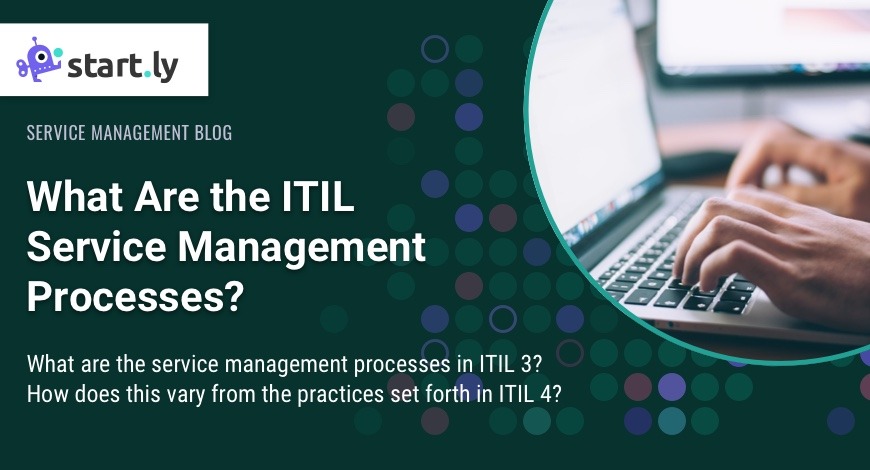In IT service management (ITSM) there is perhaps no more well-known framework than the ITIL. Originally created back in the 1980s, the Information Technology Infrastructure Library (ITIL) provides ITSM teams with a customer-centric approach to IT service management, including practices, processes, and how to manage services and deliver best-in-class results.
But what are the ITIL service management processes in ITIL 3, and what looks different in the newer ITIL 4? We’re exploring the basics in this blog. But first, let’s quickly review ITIL and service management processes in general.
What Is ITIL Used for?
ITIL is a set of best practices and strategies that are used by IT teams to effectively implement and deliver IT support services, including IT service management (ITSM). As one of the most popular IT frameworks available, companies of all sizes can use ITIL to guide strategic and day-to-day activities, including the planning, delivery, and support of IT services.
What Is a Service Management Process?
In ITIL 3, service management processes refer to the individual steps or practices that result in the design, creation, delivery, implementation, and support of IT services. Common IT service management processes include change management, incident management, and problem management—all of which can be managed with Startly’s service management platform!
However, as we’ll discuss in the next section, service management processes under the new ITIL 4 are not as rigid—in fact, they’re not called processes at all— leaving teams more room to define the processes that make the most sense for their company and their clients.
What Is the Difference Between ITIL V3 and ITIL V4?
ITIL 3 was originally released in 2007 and many ITSM companies still use the framework provided by the ITIL 3 to this day. However, in 2019 ITIL 4 was released, and many companies have updated their strategies to align with the ITIL 4. What are the primary differences and why does this matter? There is a fundamental difference between ITIL 3 and ITIL 4: process versus practice.
The ITIL 3 provides a five-step service lifecycle with clearly-defined processes that fall in each stage. This framework provides companies with clear-cut guideposts at every phase.
The ITIL 4, on the other hand, was developed with the need for customization in addition to the newest software and service management trends in mind. As such, the more narrowly defined processes have been shifted to practices that can be modified and reworked depending on business and customer needs. Let’s briefly explore the ITIL 3 and ITIL 4 processes and practices.
ITIL 3: ITIL Service Lifecycle and ITIL Processes List
ITIL 3 contains a five-step, predefined service lifecycle. Within each of the five steps, there are ITIL service management processes that help teams achieve success.
Service strategy: The first step is to align customer needs with specific actions. The five processes include:
- Strategy management for IT services
- Service portfolio management
- Financial management for IT services
- Demand management
- Business relationship management
Service Design: In the second stage, IT teams modify existing services or develop wholly new services. The 11 processes include:
- Design coordination
- Service catalog management
- Service level management
- Risk management
- Capacity management
- Availability management
- IT service continuity management
- Information security management
- Compliance management
- Architecture management
- Supplier management
Service Transition: Designed or redesigned services are built and deployed in this third stage. The eight processes include:
- Change management
- Change evaluation
- Project management
- Application development
- Release and deployment management
- Service validation and testing
- Service asset and configuration management
- Knowledge management
Service Operation: In the fourth stage, teams ensure IT services remain fully operational and provide ongoing support. The six processes include:
- Event management
- Incident management
- Request fulfillment
- Access management
- Problem management
- Facilities management
Continual Service Improvement: The final phase prompts teams to periodically review current practices to identify room for growth and improvement. The four processes include:
- Service review
- Process evaluation
- Definition of customer service improvement initiatives
- Monitoring of customer service improvement initiatives
ITIL 4: Management Practices
ITIL 4 contains 34 set management practices that fall into three unique categories: general management, service management, and technical management.
General Management: These practices have been adopted from general business management strategies and applied to IT service management to improve things like organization and operations. The 14 general management best practices include:
- Strategy management
- Portfolio management
- Architecture management
- Service financial management
- Workforce and talent management
- Continual improvement
- Measurement and reporting
- Risk management
- Information security management
- Knowledge management
- Organizational change management
- Project management
- Relationship management
- Supplier management
Service Management: These practices have been developed specifically for IT service management—with significant overlap in the processes from the ITIL 3. The 17 IT service management best practices include:
- Business analysis
- Service catalog management
- Service design
- Service level management
- Availability management
- Capacity and performance management
- Service continuity management
- Monitoring and event management
- Service desk
- Incident management
- Service request management
- Problem management
- Release management
- Change enablement
- Service validation and testing
- Service configuration management
- IT asset management
Technical Management: These processes were adopted from technology management and reworked to fit IT service management needs. The three technical management best practices include:
- Deployment management
- Infrastructure and platform management
- Software development and management
Startly: Your All-in-One Service Management Solution
At the end of the day, IT service management companies should use the ITIL version that makes the most sense for their business and their customers. Whether you’re sticking with ITIL 3 or moving to ITIL 4, one thing stays the same: the need for software solutions that support your organization’s IT service management. That’s where Startly comes in.
With Startly, ITSM teams have access to an all-in-one platform that supports time and expense tracking, service management, organizational governance, and analytics and insights. Gone are the days of working in multiple systems that don’t always talk to one another; you can truly streamline your service organization with Startly. Are you curious to learn more? Try Startly for free today.

